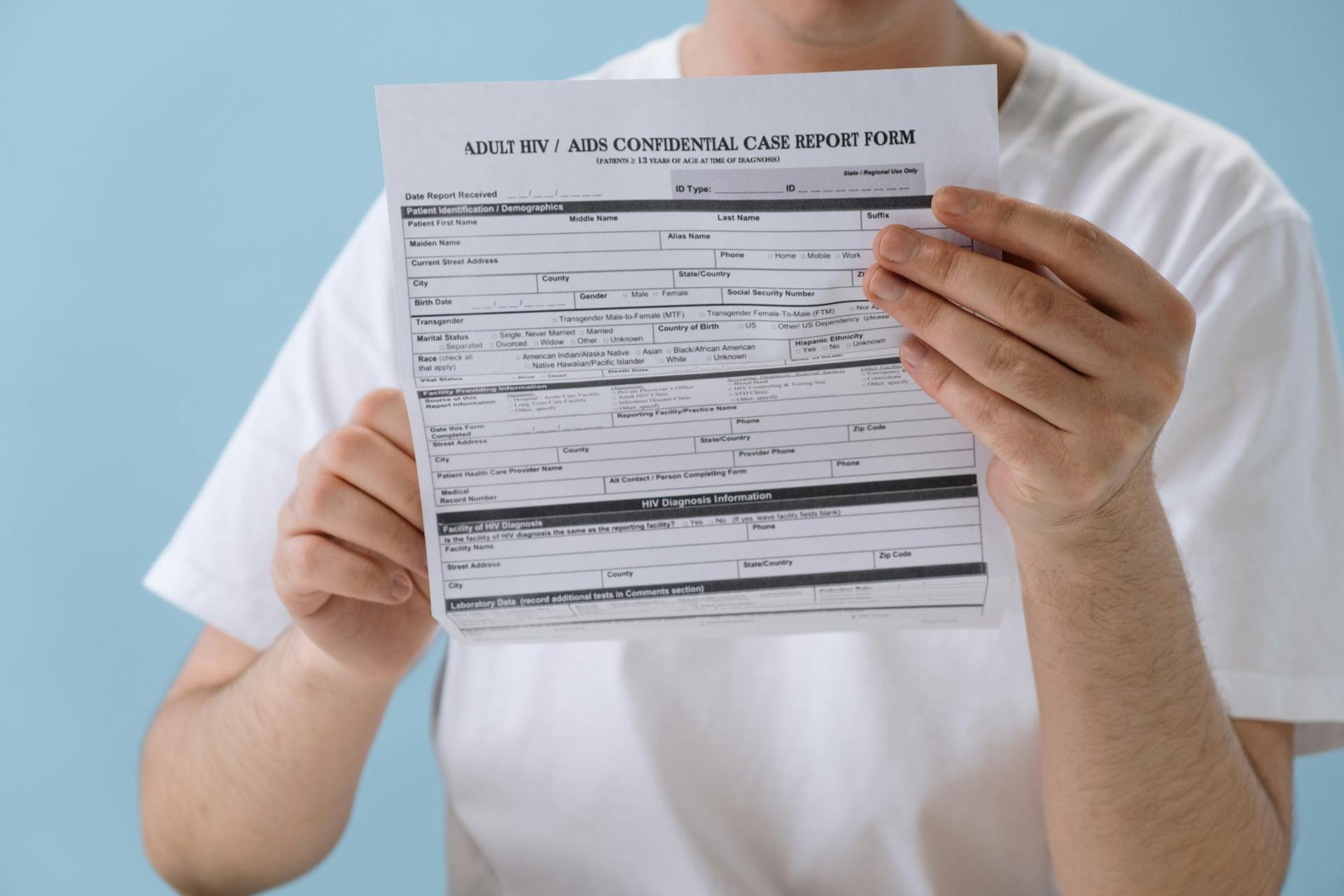
A HIPAA compliant release form is a crucial document in the healthcare industry, as it ensures that patients' sensitive information is protected and shared only with authorized parties.
To be compliant, a release form must be signed by the patient, who must be fully informed of the information that will be shared and with whom it will be shared.
The form must also include a clear statement of the patient's rights under HIPAA, including the right to revoke the authorization at any time.
A HIPAA compliant release form typically includes the patient's name, date of birth, and address, as well as the name and contact information of the entity receiving the protected health information.
On a similar theme: Medical Information Bureau Mib
What is HIPAA Compliant Release Form
A HIPAA compliant release form is a document that a patient fills out to grant permission for healthcare providers to disclose specific types of personal health information (PHI).
This type of form is required by the Health Insurance Portability and Accountability Act (HIPAA), a US federal law enacted in 1996.
The purpose of a HIPAA compliant release form is to protect patients' medical records and other health information provided to healthcare providers, health plans, and health insurers.
What Is Required?
A HIPAA compliant release form is a crucial document that requires specific information to be included. This ensures that patients are fully informed about how their protected health information (PHI) will be used and disclosed.
The form must specify the description of the information to be used and disclosed, which can be broad or narrow, depending on the purpose. This means that patients can choose to allow access to all their medical records or just specific information.
The authorized person who can use or disclose the information must also be specified, along with the names of the individuals or entities to whom the information can be disclosed. This helps maintain transparency and accountability in the sharing of PHI.
A release form must also include the purpose of the disclosure, which can vary depending on the situation. For example, if the purpose is for marketing or fundraising efforts, the form must specify this.
Readers also liked: Credit Card Debt Forgiveness for Cancer Patients
In addition to the above requirements, a HIPAA compliant release form must include the patient's signature, which indicates that they understand what information is being shared and with whom. The form must also contain an expiration date or event triggering the end of the authorization.
The following requirements must be met for a HIPAA compliant release form:
- Description of the information to be used and disclosed
- The authorized person who can use or disclose the information
- To whom it can be disclosed
- Purpose of the disclosure
- Patient's signature
- Expiration Date
- Revocation rights
These requirements are essential to maintain the integrity and confidentiality of patient PHI, while also ensuring that patients have control over their information.
Who Needs a HIPAA Compliant Release Form
If you're wondering who needs a HIPAA compliant release form, the answer is anyone dealing with healthcare data. This includes healthcare providers, health plans, and healthcare clearinghouses, as well as their business associates.
Healthcare providers like hospitals, clinics, and doctors must use these forms to gain consent and protect patient data. Health software and app developers also need to use HIPAA release forms, as do third-party vendors and business associates abroad.
Consider reading: Bcbs Data Breach
Here are some examples of entities that need HIPAA compliant release forms:
- Healthcare providers and entities
- Health software and app developers
- Third-party vendors
- Business associates abroad
- Cloud storage and data centers
- Telemedicine services
These entities need to obtain a patient's written acknowledgment of receipt of the notice of privacy practices, which is a requirement for entities with a direct treatment relationship with individuals.
Healthcare Providers
Healthcare providers play a crucial role in handling sensitive patient data, making them a key target for HIPAA compliance. As a healthcare provider, you're required to use HIPAA release forms to gain consent and protect patient data.
Healthcare providers like hospitals, clinics, and doctors must use HIPAA release forms to collect, store, or process Protected Health Information (PHI). This is a non-negotiable requirement, as stated in the article.
If you're a healthcare provider with a direct treatment relationship with individuals, you're exempt from the "notice of privacy practices" requirement. However, you still need to provide every patient with a privacy form and request their signature. This is a crucial step in educating patients about how their PHI is being used and limiting your organization's liability in case of a civil suit.
Recommended read: Bcbs Kansas City Provider Phone Number
Here are the types of healthcare providers that need to use HIPAA release forms:
- Healthcare providers and entities
- Health software and app developers
- Third-party vendors
- Business associates abroad
- Treatment of US citizens abroad
- Cloud storage and data centers
- Telemedicine services
In practical terms, providing a signature is a two-fold process: it educates the patient about how their PHI is being used and limits your organization's liability in case of a civil suit.
New York
In New York State, a HIPAA compliant release form is necessary to authorize the release of health information needed for litigation in state courts.
This form includes specific wording required under New York State Law, emphasizing the protection of patients' privacy when disclosing information.
The form can be used more broadly than just for litigation, making it a versatile tool for healthcare providers in New York.
New York State requires an emphasis on protecting patients' privacy when disclosing information relating to alcohol and drug abuse, mental health treatment, and confidential HIV-related information.
This is particularly important in New York, where patients have a right to expect their sensitive health information will be kept confidential.
Expand your knowledge: Balance Billing Washington State
California
California has a unique HIPAA release form that aligns with federal regulations and the state's own privacy law, the California Consumer Privacy Act.
This form is more comprehensive than those used in other states, which is why you may notice additional sections detailing the patient's rights and what they can expect by signing the authorization.
In California, patients have specific rights that are outlined on the HIPAA release form, which is why it's essential to use a form that complies with the state's laws.
The California Department of Health Care Services created a HIPAA release form that is tailored to the state's needs, making it a valuable resource for healthcare providers and patients alike.
By using a HIPAA compliant release form in California, healthcare providers can ensure that they are in compliance with both federal and state regulations.
Here's an interesting read: Surprise Medical Bills California
US Citizens Abroad Treatment and Data Storage
If a US citizen seeks medical treatment abroad, the foreign healthcare provider isn't directly bound by HIPAA, but transferring health records to a US-based entity may necessitate HIPAA compliance.
US citizens abroad may need to consider HIPAA compliance when seeking medical treatment, especially if their records are shared with US-based entities.
Healthcare providers abroad may not be directly responsible for HIPAA compliance, but US-based entities handling their records must follow HIPAA regulations.
Recommended read: Houston Hipaa Compliance
US Citizens Abroad Treatment

If you're a US citizen seeking medical treatment abroad, there's a chance your health records might be transferred to a US-based entity, which could require HIPAA compliance. This is because the foreign healthcare provider itself isn't directly bound by the HIPAA, meaning they aren't automatically required to follow US data protection rules.
The transfer of health records to a US-based entity can be a complex process, and it's essential to understand the implications for your data. As a result, you should be aware of the potential need for HIPAA compliance when receiving medical treatment abroad.
Recommended read: The No Surprises Act Evidence Based Practice
Texas
Texas has its own unique HIPAA release form, created by the Attorney General of Texas, which includes provisions related to the state's own privacy rules, including the Texas Medical Privacy Act.
This form specifically addresses electronic health records (EHR) and the use of Protected Health Information (PHI) in electronic formats, making it highly relevant for telehealth and remote healthcare services.
For more insights, see: Why Do You Have to Sign a Hipaa Privacy Form

Healthcare organizations in Texas can use specific language to address PHI disclosures for sale or marketing purposes, giving patients more control over their sensitive information.
If you're a US citizen living abroad, it's essential to understand the specific HIPAA regulations in Texas, including the use of electronic health records and PHI disclosures.
Florida
Florida has its own unique approach to HIPAA release forms. These forms are designed to ensure transparency in how Protected Health Information (PHI) is shared.
In Florida, the Agency for Health Care Administration's HIPAA release form is used. This form emphasizes the patient's right to revoke consent, which is a state requirement.
Patients in Florida can expect extra details on the process to revoke their consent. This is a result of the state's emphasis on transparency and patient autonomy.
The HIPAA release form in Florida typically includes information about HIV/AIDS, alcohol or drug treatment, and mental health treatment.
Readers also liked: Hipaa Certification Florida
Security and Compliance
Implementing robust security measures is non-negotiable for HIPAA compliance. Utilize encryption algorithms that are in line with industry standards.
A comprehensive evaluation of potential risks and vulnerabilities to PHI within your system is often a prerequisite for determining what security measures must be implemented. This risk assessment is crucial to maintaining data integrity and security.
Continually update your authorization forms to comply with any new amendments to the HIPAA. This ensures that your release form remains up to date and compliant with evolving regulations.
Intriguing read: Hipaa Cybersecurity Framework
Protected Health Data
Maintaining the integrity of patient information is more crucial than ever, especially with the increasing amount of healthcare-related data breaches. A properly executed HIPAA release form ensures that information is only shared when explicitly authorized, enhancing trust and data security.
Protected Health Information (PHI) refers to any information identifying an individual and relating to their past, present, or future physical or mental health condition, including healthcare services and payments. This can include medical history, treatment records, laboratory results, and more.
Readers also liked: Hipaa Compliant Computer Disposal
If the information has been de-identified according to HIPAA standards, it's no longer considered PHI and doesn't require a HIPAA release form for sharing. De-identification involves removing personally identifiable information (PII) such as name and surname, phone number, address, social security details, etc.
There are two main methods for de-identifying PHI: expert determination and safe harbor method. The safe harbor method involves removing 18 types of identifiers listed by HIPAA, such as names, geographic data smaller than a state, dates directly related to an individual (like birth date), telephone numbers, social security numbers, email addresses, and others.
A HIPAA release form is a formalized framework specifying who's authorized to access, use, or disclose PHI. It streamlines the consent process and ensures that only individuals or entities expressly approved by the patient can interact with their data.
Here are the 18 types of identifiers that must be removed for safe harbor method:
- Names
- Geographic data smaller than a state
- Dates directly related to an individual (like birth date)
- Telephone numbers
- Social security numbers
- Email addresses
- Photographs and images
- Biometric identifiers (e.g., fingerprints, voice prints)
- Full face photos and comparable images
- Any unique identifying number, characteristic, or code
- Certificate/license numbers
- Vehicle identifiers and serial numbers
- Device identifiers and serial numbers
- Web Universal Resource Locators (URLs)
- Internet Protocol (IP) addresses
- Biometric identifiers (e.g., fingerprints, voice prints)
- Facial geometry data
Emergency Situations
Emergency situations require immediate attention, and healthcare providers must be able to share patient information without consent in these cases.
In the event of an immediate threat to health or safety, PHI can be disclosed to prevent harm. This might involve sharing information about life-threatening injuries or acute medical conditions.
Public health emergencies, such as epidemics or pandemics, require the sharing of PHI to control the spread of disease. This is often done in coordination with public health agencies.
Natural disasters, like hurricanes or floods, necessitate the disclosure of PHI to coordinate patient care and locate missing persons.
National security may also require the sharing of PHI with authorized federal officials.
In cases of law enforcement, PHI may be disclosed when a person is a suspect, victim, or witness in a criminal activity that has resulted in injury.
Here are some specific situations where PHI can be shared without consent:
- Immediate threats to health or safety
- Public health emergencies
- Natural disasters
- National security
- Law enforcement
- Organ transplants
- Firearm injuries
- Overdose cases
- Mental health crises
- Child abuse or neglect
- Adult and domestic abuse
Business Associate Agreement and Minimum Necessary Rule
A Business Associate Agreement (BAA) is a must-have when a third-party service provider needs access to Protected Health Information (PHI). This document outlines the responsibilities and security measures for both parties.
To ensure HIPAA compliance, a BAA should be signed before PHI is shared. This agreement helps protect sensitive patient data.
Developers can implement the Minimum Necessary Rule at the code level to limit access permissions. This principle dictates that only the minimum necessary information required to complete a task should be disclosed.
By following the Minimum Necessary Rule, you can help prevent unauthorized access to PHI. This is especially important when working with third-party service providers who may need access to patient data.
Here are some key points to consider when implementing the Minimum Necessary Rule:
- Limit access permissions to only what's necessary for the task at hand
- Implement security measures to protect sensitive patient data
- Ensure that only authorized personnel have access to PHI
Business Associate Agreement
A Business Associate Agreement (BAA) is a crucial document that must be signed when a third-party service provider can access Protected Health Information (PHI). This agreement details the responsibilities and required security measures for both parties.
You might enjoy: Mortgage Assumption Agreement
A BAA is necessary to ensure that PHI is handled and protected properly, and it's a requirement for any third-party service provider that can access PHI. This includes companies that provide services to healthcare entities, such as cloud storage providers or billing companies.
Developers need to implement the minimum necessary rule at the code level to limit access permissions, which means only disclosing the minimum necessary information required to complete a task. This principle is essential for respecting patient choices and streamlining interoperable healthcare solutions.
The BAA document outlines the responsibilities of both parties, including the third-party service provider and the healthcare entity, to ensure the secure handling of PHI. This includes implementing security measures to protect PHI and notifying the healthcare entity in the event of a breach.
Broaden your view: Healthcare Asset Management Companies
Authorization Core Elements
In a HIPAA authorization form, there are specific core elements that must be included to ensure compliance and protect patient data. These elements are crucial for respecting patient choices and streamlining interoperable healthcare solutions.
A description of the PHI to be used or disclosed is essential, identifying the information in a specific and meaningful manner. This ensures that patients understand what data is being shared.
The names or other specific identification of the person or persons authorized to make the requested use or disclosure must be included. This could be the patient themselves or their authorized representative.
A description of each purpose of the requested use or disclosure is also necessary. This helps patients understand why their data is being shared.
An authorization expiration date or expiration event is required, which relates to the individual or to the purpose of the use or disclosure.
A signature of the individual and date is a critical element, as well as a description of the representative's authority to act for the individual if applicable.
Here are the Authorization Core Elements in a concise list:
- A description of the PHI to be used or disclosed
- The names or other specific identification of the person or persons authorized to make the requested use or disclosure
- The names or other specific identification of the person or persons to whom the covered entity may make the requested use or disclosure
- A description of each purpose of the requested use or disclosure
- Authorization expiration date or expiration event
- Signature of the individual and date
Frequently Asked Questions
How to write a HIPAA release letter?
To write a HIPAA release letter, follow a 7-step process that includes naming the patient and authorized individual, describing the information to be disclosed, and specifying recipients, purpose, and time period. Start by obtaining the patient's signature after completing the required details.
Does HIPAA release have to be notarized?
Notarization is only required for HIPAA releases related to court or legal matters, not for general releases. A patient's or representative's signature is sufficient for most cases
How do I make a form HIPAA compliant?
To make a form HIPAA compliant, use a HIPAA compliant forms builder and implement features like electronic signatures, required form fields, and conditional logic to protect sensitive patient information. By following these steps, you can ensure your online forms meet the necessary security and data protection standards.
Sources
- https://www.feathery.io/blog/hipaa-release-form
- https://www.fit.edu/research/faculty--researchers/compliance/human-subjects-regulation/hipaa-forms-and-regulations/
- https://secureframe.com/blog/hipaa-release-form
- https://compliancy-group.com/hipaa-release-forms-your-101-guide/
- https://www.hipaahq.com/hipaa-forms-explained-privacy-and-authorization/
Featured Images: pexels.com

